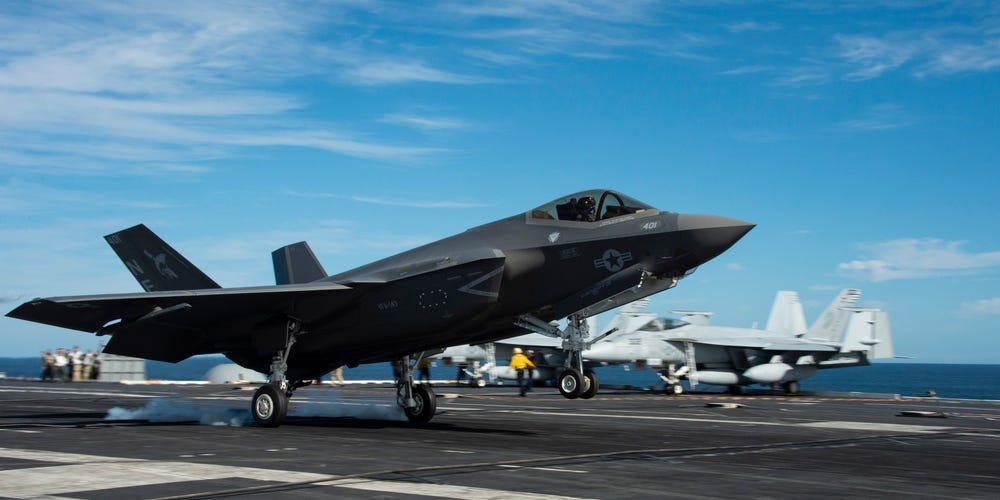
- In January, an F-35 fighter jet crash-landed on aircraft carrier USS Carl Vinson and fell into the South China Sea.
- A leaked video shows the fifth-generation stealth fighter slam into the flight deck.
- Insider spoke with an a former US naval aviator about the video of the crash.
A F-35C stealth fighter crash-landed last month on the US Navy aircraft carrier USS Carl Vinson while it was operating in the South China Sea. In the days that followed the crash, a video was leaked showing the jet striking the carrier's deck before falling into the ocean.
In the video, someone can be heard shouting "wave off" just moments before the jet assigned to the "Argonauts" of Strike Fighter Squadron (VFA) 147 crashes into the ramp, bursts into flames, and slides across the flight deck.
Five sailors have been charged with leaking the video of the crash, the cause of of which has yet to be explained by the Navy as an investigation is still ongoing. Seven service members were injured in the incident, including the pilot who ejected and was recovered by helicopter.
—Fighterman_FFRC (@Fighterman_FFRC) February 6, 2022
Insider spoke with retired Cmdr. Guy Snodgrass, a former US naval aviator and TOPGUN instructor, about what we are seeing in the leaked video.
"The one thing we know is certainly true is that for whatever reason, the pilot or the airplane got too low on the approach, and that's what caused the ramp strike," Snodgrass said, adding that it is likely a slow airspeed contributed to the crash.
But it is hard to say whether the crash was due to human error or to some technical malfunction, he explained.
"Just from that video, it's impossible to tell if the pilot was flying manually or if the plane was assisting with the landing," he said. "So that's a key component we would need to know to make a better evaluation."
Snodgrass said when pilots are flying manually – with fighter jets like the F-35C – a ramp strike tends to occur when the pilot starts to go too slow, having pulled the throttle back too far and developing a sink rate that's steeper than expected.
This, according to Snodgrass, is like a "point of no return," because even if you push the throttle all the way forward or go into afterburner – a method of increasing the engine's thrust for a short period of time – it's too late to stop the descent and start climbing again.
"If it happens at that wrong spot, then no matter what you do, there's really nothing that's going to prevent that type of a ramp strike," Snodgrass said.
The leaked video shows the plane's pilot eject as the fiery fifth-generation fighter slides across the deck. Sailors on the flight deck can be seen rushing about as the plane crashes into the sea.
The fighter ripped out all four arresting wires, cables the plane hooks onto during recovery. It took the ship's crew, which immediately sprang into action, about 30-45 minutes to get the carrier ready to fight again after the incident.
January's crash was the sixth known F-35 crash, and it comes on the heels of another F-35 crash involving the British Royal Navy. That jet crashed into the Mediterranean during flight operations off the British aircraft carrier HMS Queen Elizabeth in November 2021. That jet was recovered the next month.
The Navy is still in the process of pulling January's crashed F-35 out of the South China Sea, which they want to do before anyone else might attempt to get their hands on it.
Though China has denied having any interest in the aircraft, experts say China would almost certainly want to get ahold of the F-35, a highly capable fifth-generation fighter jet that has taken many years and significant funding to research and develop.
"If China gets it now, they've recovered some of our latest and greatest technology," Snodgrass explained. "So it raises not only a question about the airframe and the aircraft itself, but it also raises a question about security."
"It is our property," Pentagon press secretary John Kirby said earlier this month in response to questions about the jet. "It is not uncommon for us to recover our property when it is lost at sea. And we are making every effort to do that in this case."